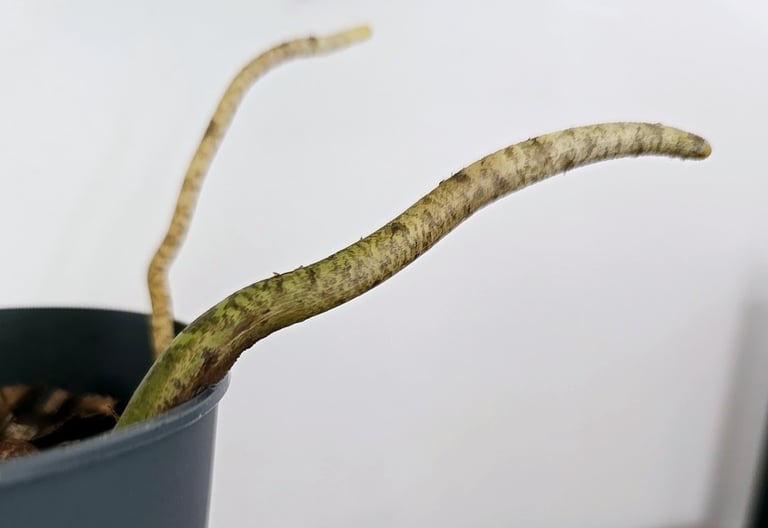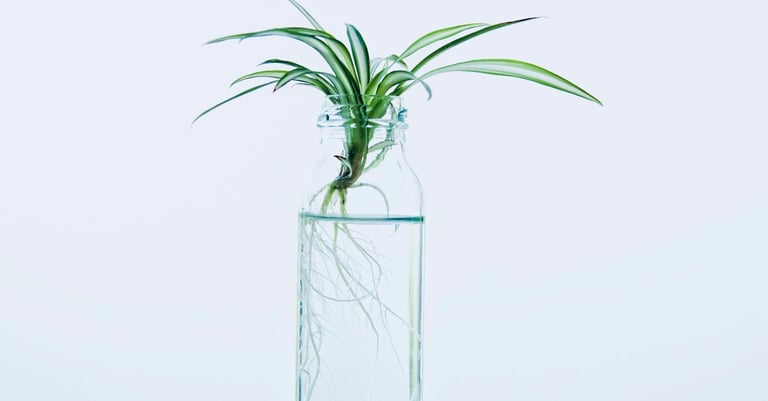Guide To Rooting Hormones: How To Grow Roots Faster
How rooting hormones grow roots faster, even in water. Explore natural vs synthetic, plants they won't work with, the science, & misconceptions.
SCIENCEEDUCATIONPLANT CAREPROPAGATIONHOW-TO
How To Grow Roots Faster: How Rooting Hormones Accelerate Growth During Propagation
Table Of Contents
Quickly navigate this page to find any topic in the article
How To Grow Roots Faster
Plant propagation is an essential skill for gardeners and houseplant enthusiasts alike. It allows you to multiply your favourite plants, share them with friends, and save money when creating large plant displays.
One of the key factors in successful propagation is the timely development of healthy roots. Cuttings have a limited amount of energy stored in their leaves after being separated from the parent plant. The faster the roots develop, the fewer chances there are of the cutting failing. If the cutting doesn't produce roots before it runs out of energy, it will die of starvation.
This is where rooting hormones come into play. Rooting hormones can significantly speed up the rooting process, helping cuttings to develop roots faster and more robustly. Studies have shown that using rooting powder can lead to quicker rooting and establishment.
In this article, we'll explore the science behind rooting hormones, how they work, and the benefits they offer to gardeners looking to propagate plants efficiently. Whether you're a seasoned gardener or a beginner, understanding the role of rooting hormones can elevate your propagation efforts and help you grow houseplant roots faster during propagation.
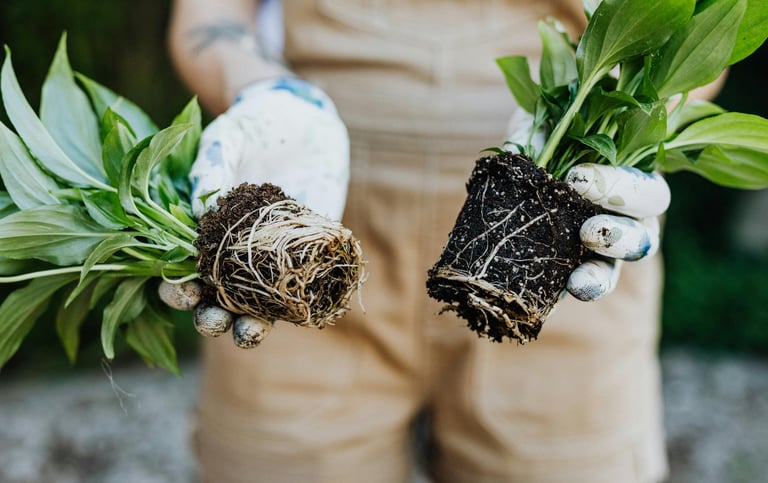

Key Points:
Types of Rooting Hormones: Rooting hormones come in different forms—powder, liquid, gel, and natural alternatives—each with distinct benefits for plant propagation.
How They Work: Rooting hormones accelerate root development by promoting cellular activity at the cutting's base, which is essential for successful propagation.
Practical Applications: To use rooting hormones effectively, dip the cut end of your plant into the hormone, then plant it in soil or water.
Expert Advice: Horticulturists recommend using rooting hormones to increase chances of success during propagation, and to encourage faster rooting and development in cuttings.
Our Experience: We highly recommend using hormones during propagation, as we've seen decreased losses, fewer instances of disease, and faster establishment and growth. When we compare treated cuttings to untreated cuttings, the results are remarkable. Rooting hormone allows plants to develop larger, healthier, more dense root systems much faster than in untreated plants, and it helps to reduce cutting losses.
Types Of Rooting Hormones
Rooting hormones come in various forms, each with its unique properties and benefits. Understanding the different types can help you choose the most suitable one for your plant propagation needs. Whether you opt for synthetic powders, natural alternatives, or seaweed extract, using rooting hormones can significantly boost your success rate and promote healthier root growth in your cuttings. Here are some of the most common types:
Powder Rooting Hormones
Powder rooting hormones are popular due to their ease of use and effectiveness. These powders typically contain synthetic auxins, such as Indole-3-butyric acid (IBA) or Naphthaleneacetic acid (NAA), which stimulate root growth. To use, simply dip the cut end of your plant cutting into the powder, ensuring it is coated evenly before planting. At the nursery, we like to mix our rooting powder with mycorrhizal fungi powder, as it forms a symbiotic relationship with plant roots, enhancing nutrient and water absorption. When combined with rooting hormones, the two can work together to improve overall plant health and growth.
Where To Buy Powder Rooting Hormones: Powder hormones are relatively easy to find, with several brands available, including Doff Organic, Westland Organic, Vitax Organic, and Doff Synthetic.
Liquid Rooting Hormones
Liquid rooting hormones can be found in two forms: concentrated and ready-to-use solutions. Concentrated solutions need to be diluted with water before use, while ready-to-use solutions can be applied directly to the cuttings. Liquid hormones often provide more consistent results and can be easily absorbed by the plant tissues.
Where To Buy Liquid Rooting Hormones: You can find liquid rooting hormones online, including Miracle-Gro's Liquid Rooting Stimulant.
Gel Rooting Hormones
Gel rooting hormones are a convenient option that offers the benefits of both powder and liquid forms. The gel adheres well to the cuttings, providing a protective layer that promotes root development. Gels also help maintain moisture around the cut end, creating an optimal environment for root formation. To make your own rooting gel at home, mix rooting hormone powder with aloe vera gel (100% pure or freshly squeezed from the plant) to create a homemade rooting hormone gel. Use a ratio of about 1 part powder to 4 parts gel, mixing thoroughly.
Where To Buy Gel Rooting Hormones: You can find most gels online, including Westland Organic, ROOT!T, Vitax Organic, and our personal favourite, Clonex.
Natural Rooting Hormones
For those who prefer organic or natural alternatives, several natural rooting hormones can be used, including:
Willow Water: Made from soaking willow branches in water, willow water contains natural rooting compounds, including salicylic acid and indole-3-butyric acid, which encourage root growth. We make our own tincture at the nursery by adding willow bark to a container of water and allowing it to steep for a few weeks, burping the lid occasionally to prevent pressure build-up. This is known as a homemade jadam, perfect for helping roots develop faster during propagation.
Honey: Known for its antibacterial properties, honey can help protect cuttings from infections while promoting root development. Always buy good quality honey, as cheaper brands are often contaminated with sweet syrups that could cause issues for houseplants. If you can find raw honey from a local beekeeper, you can guarantee the purity of the honey.
Cinnamon: Acting as a natural fungicide, cinnamon can help prevent fungal infections in cuttings, although it doesn't directly stimulate root growth. Always use pure cinnamon, not the sweet cinnamon commonly used in baking. You can usually find it at your local supermarket, however, it can be cheaper to purchase it online if you need lots of it. You can buy smaller 300g bags, or larger 1 kg bags for those with larger houseplant collections.
Scindapsus Or Pothos Cuttings: Pothos or Scindapsus cuttings release natural rooting hormones into the water, helping other plant cuttings to root and establish faster. Place a Pothos cutting in your water propagation jar to give other cuttings a boost. In our experience, this technique works exceptionally well to speed up the development of other cuttings, and we use it constantly at our houseplant nursery. We've found that when a Pothos cutting is added, other species develop roots faster, establish more quickly, and start producing new foliage sooner compared to cuttings grown without this method. In our experiments, we've observed that species which typically take a long time to develop roots in water can establish themselves more than twice as fast when Pothos cuttings are added to the water. We observed that some particularly fussy species didn't root in water at all without the presence of Pothos cuttings.
Vermicompost Extract
Vermicompost extract, another favourite here at the nursery, is produced through the bio-oxidation of organic waste by earthworms. Vermicompost liquid is rich in nutrients, growth regulators, and beneficial microorganisms. Studies have shown that vermicompost extract promotes plant growth by enriching the soil with essential nutrients, growth-regulating hormones, and beneficial microorganisms. Its components, including humic acids and plant growth hormones, make it a valuable addition to rooting hormone formulations. Vermicompost extract is rich in growth regulators, including auxins like Indole-3-butyric acid (IBA) and Indole-3-acetic acid (IAA), which are known to promote root development. In our experience, vermicompost extract is a valuable addition to propagation for much more than just the rooting hormones, and it can help to speed up root development in cuttings.
Where To Buy Vermiculture Extract: Ecoworm Soil Extract


Seaweed Extract
Seaweed extract is another natural rooting hormone that has gained popularity among gardeners. Rich in growth hormones, vitamins, and minerals, seaweed extract can enhance root development and improve the overall health of cuttings. It can be used alone or combined with other rooting hormones for added benefits. We add a drop to our jars of water when propagating in water, as we've found that cuttings develop roots faster when seaweed is used. To use seaweed extract for root development, dilute it with water according to the product instructions for propagation and apply it to the cuttings or soil. If the packaging has no directions for cuttings, add 50% less seaweed concentrate to dilute it down for propagation.
Where To Buy Seaweed Extract: Maxicrop, Envii, Doff, Empathy, Empathy Ready Mixed, Alga-sol, Multi-Mite, and Vitax
The Benefits Of Using Rooting Hormones
Rooting hormones help plant cuttings grow roots more quickly, with a higher success rate and fewer incidents of disease. These hormones aid in developing healthier root systems, making them a magic potion for plant propagation—your secret weapon.
Faster Root Development
Rooting hormones speed up the process of root growth, so your plant cuttings can establish themselves more quickly and start feeding before they run out of energy. Plants have a limited store of energy in their leaves when they're cut from the parent plant, and by developing roots quickly, the plant can start feeding before it runs out of vital energy stores. Cuttings can starve to death if their roots don't develop before they run out of stored energy.
When rooting hormone is applied to plant cuttings, the hormones stimulate root cell formation and elongation, significantly accelerating the rooting process. This rapid root development is crucial for the survival of cuttings, as they can establish themselves and begin absorbing water and nutrients sooner, preventing them from running out of energy and slowly starving to death. This can be the difference between a successful cutting, and one that limps along and eventually dies without forming any roots to provide food to the plant.
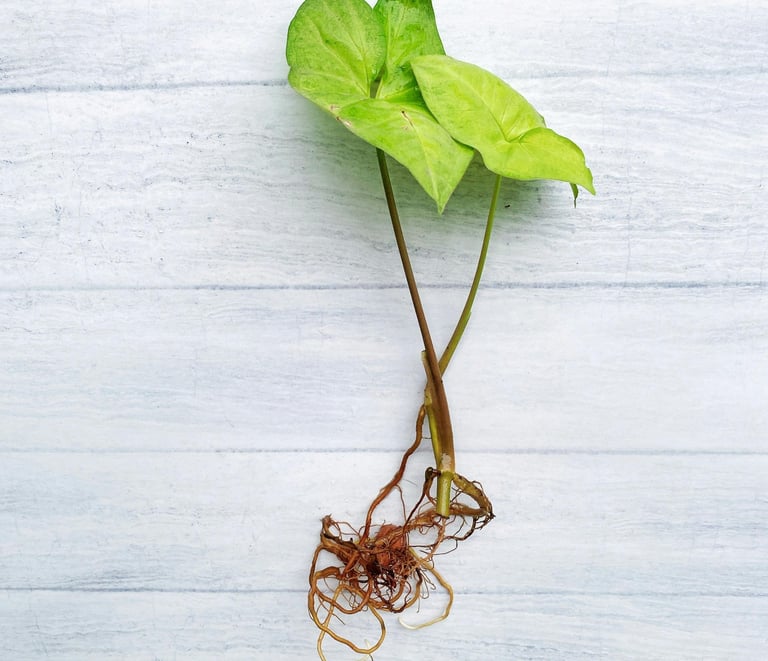

Improved Success Rates
Using rooting hormones increases the chances that your plant cuttings will successfully grow into new plants. Rooting hormones enhance the overall success rate of plant propagation by promoting uniform and consistent root growth. They reduce the risk of cutting failure, which can be caused by slow or inadequate root formation. By providing the necessary hormonal signals, rooting hormones ensure that a higher percentage of cuttings develop strong roots and thrive. In our experience, hormones help most types of plants, except a few notable species, and some woody stemmed plants. We've explored which species don't respond well to rooting hormones later on in this article.
Healthier Root Systems
Rooting hormones help cuttings to grow stronger, healthier roots, which support better overall plant health. The auxins found in rooting hormones not only promote root formation, but also improve the quality and structure of the root system. Healthier root systems result in more robust plants with increased resistance to environmental stresses, diseases, and pests. Well-developed roots also enhance the plant's ability to absorb water and nutrients, leading to better growth and productivity.
How Rooting Hormones Impact Plant Growth
When you apply rooting hormones to a plant cutting, the hormones help to create new roots by mimicking natural plant hormones. If you've ever heard the saying, “Put a Pothos cutting in with your water propagation jar to speed up rooting,” then you are familiar with natural plant hormones. Pothos cuttings tend to release larger amounts of natural rooting hormones into the water, helping other species to root and establish faster. Providing hormones during propagation is like giving the plant a little nudge to grow roots faster. Rooting hormones work by mimicking the natural auxins produced by plants, like the ones made naturally by Pothos cuttings. For a deeper dive into what auxins are, how they influence growth and development, head to our science section to explore how auxins work, and the different types available in rooting hormones.
How To Use Rooting Hormones
Using rooting hormones can significantly enhance the success of your plant propagation efforts. Here's a step-by-step guide to help you through the process:
How To Prepare Cuttings For Rooting Hormones
Start by getting your plant cuttings ready for their new adventure. Make sure they have a fresh, clean cut to absorb the rooting hormone. Choose healthy, disease-free cuttings from the parent plant. Ensure that each cutting is around 4-6 inches long and has at least a couple of healthy leaves. Using a sharp, sterilized knife or scissors, make a clean cut just below a leaf node. Remove any lower leaves that might come into contact with the rooting medium to prevent rotting.
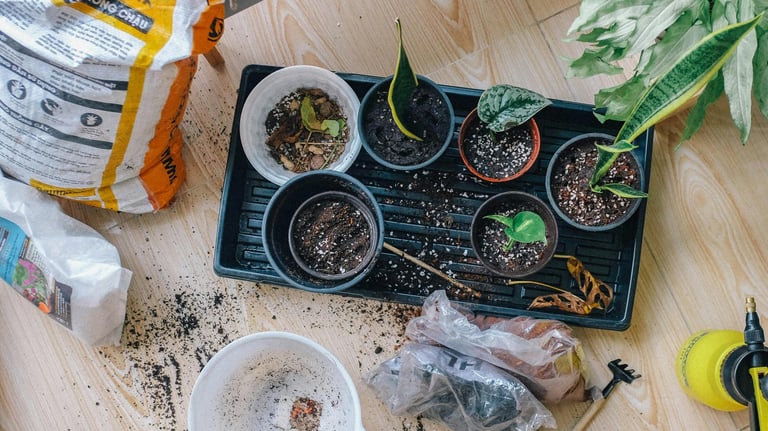

How To Propagate With Rooting Hormones
Choose the Right Form: Rooting hormones come in various forms, such as powders, gels, and liquids. Select the form that suits your preference and the type of plant you're propagating.
Use a Separate Container: To avoid contaminating the entire container of rooting hormone, pour a small amount into a separate container for dipping the cuttings. Discard any leftover hormone after use to maintain hygiene.
Dip the Cuttings: Dip the base of each cutting into the rooting hormone. If you're using a powder, tap off any excess to avoid over-application. For gels and liquids, ensure the base is well-coated.
Hardening Off: Let the cuttings sit in a dry, shaded area for a minimum of 30–60 minutes before continuing with propagation as normal. This allows the rooting hormone time to absorb, and lets the cut ends to start callousing over, reducing the risk of rot and disease. We've found that this helps to reduce the risk of cutting losses and increases success rates.
Prepare the Planting Medium: Fill a small pot with a well-draining planting medium, such as our houseplant soil recipe. Make a small hole in the centre for the cutting. We like to sprinkle a little rooting powder into the hole, along with some mycorrhizal fungi, which helps to promote good soil health.
Plant the Cuttings: Insert the treated end of the cutting into the hole, ensuring the cutting is firmly in place. Gently press the soil around the cutting to secure it. Don't press too hard, as we've found that some species, particularly aroids, can struggle when the soil is too compacted.
Watering: Water the cuttings lightly to settle the surrounding soil with room temperature dechlorinated water. We like to add a tiny drop of seaweed extract to our cutting water to promote faster root development, as it contains natural rooting hormones. Keep the soil moist but not waterlogged.
Provide Optimal Conditions: Place the cuttings in a warm, bright location with indirect light. Avoid direct sunlight, which can stress the cuttings. Add artificial lighting if light levels are too low to promote growth, like during the winter, or in low lighting environments. Cover the cuttings with a plastic bag or a humidity dome to create a humid environment. This helps prevent the cuttings from drying out.
Monitor and Care: Check the cuttings regularly for signs of growth. Water as needed and ensure they are kept in a stable environment. Once roots have developed, gradually acclimate the new plants to normal growing conditions and follow the correct plant care routine for the species of plant.
How To Apply Rooting Hormone For Water Propagation
Dip In Rooting Hormone: In our experience, we've found that it's beneficial to dip the ends of our water cuttings into rooting hormone, even when propagating in water. Rooting hormone is not usually water-soluble, so it's important to do this step before the cuttings go into the water when using this method. Once the stem touches the water, the rooting hormone is washed off, so we always recommend doing this step before you wet the cuttings and allowing some time for them to absorb before hydrating the cuttings.
Hardening Off: Let the cuttings sit in a dry, shaded area for a minimum of 30–60 minutes before continuing with propagation as normal. This allows the rooting hormone time to absorb, and lets the cut ends to start callousing over, reducing the risk of rot and disease. We've found that this helps to reduce the risk of cutting losses and increases success rates.
Hydrate the Cuttings: Place the calloused cuttings in water to prevent them from drying out. This helps keep the cuttings hydrated and ready to absorb the rooting hormone. We only use room temperature dechlorinated water, and we like to add one tiny drop of seaweed extract to our cutting water, as it contains natural rooting hormones. In our experience, we've found that seaweed helps to promote root development in the same way that rooting hormone powder or gel does. We've found that this helps to speed up establishment, foliage growth, and provides faster rooting times when compared to cuttings grown without seaweed extract.
Allow Roots To Develop: Over time, roots will develop, and your cutting will be ready to transfer to soil. When your cutting is ready, move to step 5 of the “How To Apply Rooting Hormone” section above and continue propagation as normal.
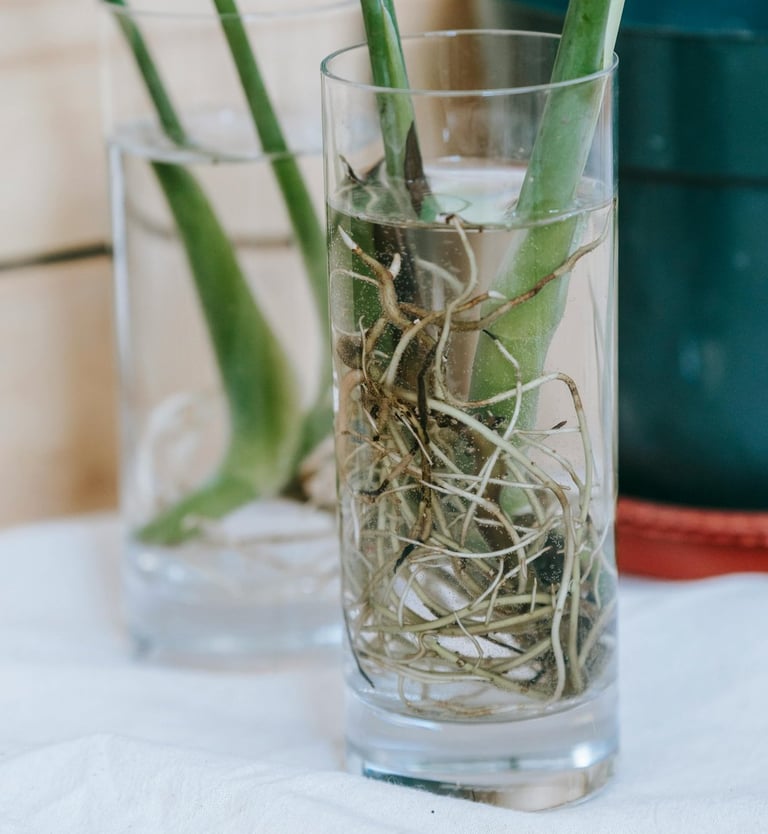

Common Myths and Misconceptions
There are many myths and misconceptions about the use of rooting hormones. Let's clear them up so you know what really works and what doesn't.
Debunking Common Roothing Hormone Myths
Here are some common myths about rooting hormones and the truth behind them.
Myth: Rooting Hormones Guarantee 100% Success
Reality: While rooting hormones significantly improve the chances of successful rooting, they don't guarantee 100% success rates for propagation. Factors such as the health of the cutting, the type of plant, and environmental conditions also play crucial roles in the rooting process. No matter how effective the hormone is, it can't compensate for low lighting, low humidity, or extreme temperatures. General plant care significantly impacts the success rates of cuttings.
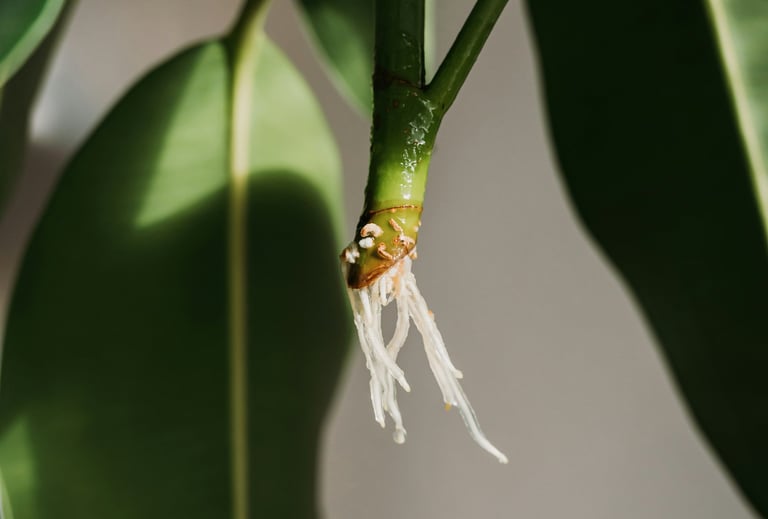

Myth: More Rooting Hormone Equals Faster Rooting
Reality: Applying more rooting hormone than recommended does not speed up the rooting process and can actually harm the cutting. Follow the instructions on the product to achieve the best results. Studies have found that applying multiple applications of rooting hormone can be beneficial, but this is different to over applying hormones on the first application. For more information about this, head to our research and case studies section.
Myth: Rooting Hormones Are Only For Professionals
Reality: Rooting hormones are affordable, widely available on Amazon and in local stores, and easy to use, making them accessible to hobbyists and professionals alike. With a little guidance, anyone can use rooting hormones to propagate plants successfully.
Myth: Rooting Hormones Are Harmful To Plants
Reality: When used correctly, rooting hormones are safe and beneficial for plants. They are designed to mimic natural plant hormones that the cuttings would produce when cut, promoting healthy root development without causing harm. All cuttings make some of their own rooting hormones naturally. By adding extra rooting hormone, you're cutting out a chunk of time when the cutting had to focus on creating rooting hormones, and providing them in a readily available form to allow the plant to start producing roots faster. This can be seen naturally by adding a Pothos or Scindapsus cutting to water propagations, as these species release higher than average levels of rooting hormones into the water, which can help to speed up the establishment of other species. If rooting hormones were harmful to plants, adding a Pothos cutting would hinder and harm propagation, not encourage faster rooting and establishment.
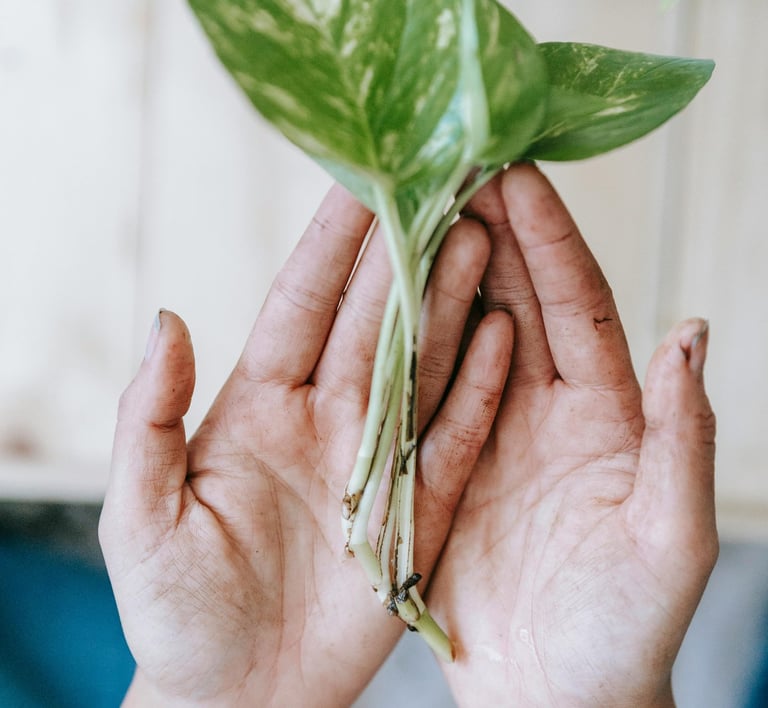

Understanding The Limitations Of Rooting Hormones
Rooting hormones are helpful, but they can't solve all problems. Here are their limitations.
Rooting Hormones Are Not A Substitute For Proper Care: Rooting hormones can enhance root growth, but they cannot replace proper care and attention. Cuttings still need the right environment, moisture, humidity, temperature, and light to thrive. No matter how effective rooting hormones are, they can't compensate for incorrect species specific plant care. When combined with the right environment and plant care, rooting hormones can speed up establishment during propagation.
Rooting Hormones Are Not A Cure-All For Poor Cuttings: Using rooting hormones will not revive unhealthy or damaged cuttings. It's essential to start with healthy, disease-free cuttings for successful propagation. Try to avoid taking cuttings with yellowing leaves, or crispy brown leaf tips, and if there's a pest infestation, try to deal with the pests before starting propagation, unless it's to try to save a pest riddled plant.
Environmental Factors Still Matter When Using Rooting Hormones: Factors such as temperature, humidity, and light levels can impact the effectiveness of rooting hormones. Ensure that your cuttings are placed in optimal conditions for root development.
Species-Specific Effectiveness Of Rooting Hormones: Some plant species respond better to rooting hormones than others. There are some houseplants that don't respond well to rooting hormones. For these plants, it's important to consider alternative propagation techniques and provide the right environment for successful rooting. Focus on using methods such as leaf cuttings, stem cuttings, offsets, or division, depending on the plant type. Allow cuttings to callous over for a minimum of 30–60 minutes before planting to prevent rot, and ensure they are placed in a well-draining soil mix. Maintain high humidity by covering cuttings with plastic or using a humidity dome, and provide indirect light to prevent stress. Keep the soil consistently moist but not waterlogged, and regularly check the cuttings for signs of root development. By tailoring your approach to the specific needs of each plant, you can improve your chances of successful propagation even without rooting hormones. Here are some houseplant species that are known to be resistant to rooting hormones:
African Violet (Saintpaulia spp.)
Bromeliads (Bromeliaceae family)
Cacti and Succulents (Cactaceae and various succulent families)
Ferns (Polypodiopsida)
Peace Lily (Spathiphyllum spp.)
Spider Plant (Chlorophytum comosum)
Zamioculcas zamiifolia (ZZ Plant)
Orchids (Orchidaceae family)
Air Plants (Tillandsia spp.)
Begonias (Begonia spp.)
Philodendrons (Philodendron spp.)
Pothos (Epipremnum aureum)
Rubber Plants (Ficus elastica)
Snake Plants (Sansevieria spp.)
Christmas Cactus (Schlumbergera spp.)
Jade Plant (Crassula ovata)
Prayer Plant (Maranta leuconeura)
Research & Real World Experience
We're serious about propagation; our business is built on it. At our houseplant nursery, we're constantly watching for new research on plant propagation, including rooting hormones. When we find new studies, we will add them to this page, so check back occasionally for cutting edge new scientific research on rooting hormones.
Research On Multiple Applications Of Rooting Hormones
Research has shown that multiple applications of rooting hormones can enhance rooting in certain plants. For instance, secondary applications of K-IBA rooting solutions on leafy cuttings have been found to improve rooting efficiency, especially for slow-to-root cuttings.
How To Use This Research At Home: Applying rooting hormones more than once can enhance rooting efficiency, especially for slow-to-root plants. Propagate as usual and start with an initial application of rooting hormone to the cutting's base, and place it into the soil or water. After 1–2 weeks, apply a diluted solution of rooting hormone to the base of the cutting or the surrounding soil or water. Repeat this process once or twice more at similar intervals if needed. This sustained boost helps promote healthy root development, improving the chances of successful propagation.
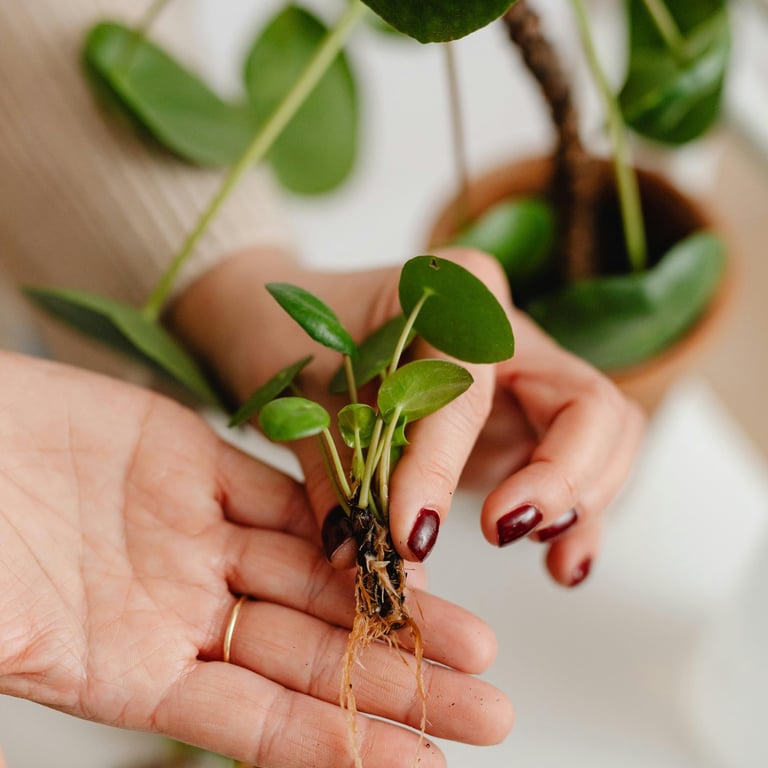

Research On The Effects Of Different Growth Hormones On Rooting
Different types and concentrations of growth hormones can affect how well plant cuttings root. Research on Morus alba L. cuttings demonstrated that different concentrations of IAA, IBA, and ABT-1 significantly influenced rooting efficiency. The optimal concentrations of ABT-1 (500 mg·L−1 and 1000 mg·L−1) achieved the highest rooting efficiencies for vegetable and fruit mulberry cuttings.
How to Use This Research At Home: To use this technique at home, choose a rooting hormone product with the appropriate concentration of IAA, IBA, or ABT-1 for your plant cuttings. Follow the instructions on the product label for application. For best results, make sure to apply the hormone to healthy, disease-free cuttings and provide them with optimal conditions. Finding rooting hormone products with specific concentrations of IAA, IBA, or ABT-1 can be a bit tricky, as these are often used in research settings rather than commercial products. However, here are some general recommendations for rooting hormone products available that contain some of these compounds:
Doff Rooting Powder: Contains IBA (Indole-3-butyric acid), commonly used for promoting root development in various plant cuttings.
Vitax Organic Rooting Powder: Contains natural rooting hormones, including IBA.
Clonex Rooting Hormone: Available in liquid form, Clonex contains IBA and is known for its effectiveness in promoting root growth.
While these products may not specify the exact concentrations of IAA, IBA, or ABT-1, they are widely used and trusted by gardeners for successful propagation. For precise concentrations, you might need to look into specialized horticultural suppliers or research-grade products.
Research On In Vitro Rooting
Growing gerbera plants in a controlled lab environment can achieve nearly perfect rooting success by using specific rooting hormones. A study on the in vitro rooting of gerbera plantlets revealed that full-strength MS media supplemented with 1000 ppm NAA resulted in a 99.6% rooting success rate. This highlights the effectiveness of specific concentrations of rooting hormones in promoting root development.
How To Use This Research At Home: Clonex is one of the few commercially available products known to contain NAA, although not in the exact concentrations used in the study. It can be challenging to purchase NAA in a domestic setting, as it's usually sold in large quantities to commercial growers. MS media (Murashige and Skoog media) is a nutrient-rich solution used in plant tissue culture to support the growth of plant cells and organs. Developed in 1962, it contains essential nutrients for plant growth in a controlled environment. While you may not have access to full-strength MS media, you can still improve rooting success by selecting healthy cuttings, applying rooting hormone as directed, and providing optimal growing conditions.
Real-World Experiences
Gardeners on Reddit and various forums frequently share their personal experiences with rooting hormones, providing valuable insights and tips. We've added some of our own experiences when running a houseplant nursery, to help give you some real world advice on using rooting hormones.
Thicker & Denser Root Systems: Online gardeners have discussed their experiments with rooting hormones, noting differences in root thickness and overall health between treated and untreated cuttings. We've seen the results of this first hand at our houseplant nursery, with plants treated with rooting hormone developing roots faster, and creating stronger, healthier, and denser root systems that help to provide faster overall growth, and healthier foliage. In our experience, rooting hormones are especially effective when combined with mycorrhizal fungi as it forms a symbiotic relationship with plant roots, improving nutrient and water uptake. This symbiosis helps the plant absorb essential nutrients more efficiently, which supports healthier and more vigorous root systems.
Natural Rooting Hormones VS Synthetic Rooting Hormones: Some gardeners have found that while rooting hormones can speed up root formation, natural methods like using willow water, seaweed, or honey can also be effective. We're massive fans of seaweed at the nursery, and we have great experiences using it to aid root development of cuttings for both water and non-water propagation. In our experience, seaweed can help to promote faster root development in water cuttings when a tiny drop is added to the water vessel. We've also found that seaweed is effective when added to the propagation medium via watering. Natural rooting agents, like seaweed extract, are rich in natural plant growth promoters, including cytokinins, auxins, and other beneficial compounds. While rooting hormone powders typically contain synthetic auxins like IBA (Indole-3-butyric acid) to stimulate root growth, seaweed extracts provide a broader range of nutrients and biostimulants that can enhance overall plant health and vigor. Using them together can create a more favourable environment for root development by combining the targeted action of synthetic auxins with the nutrient-rich benefits of seaweed extracts. This combination can improve root formation, increase nutrient uptake, and help plants better withstand environmental stresses.
Activating Dormant Aerial Roots: Discussions on forums highlight the success of using rooting hormones for propagating dormant aerial roots, with many users reporting positive results. We've found that dipping aerial roots into hormones before planting helps to speed up establishment and development.
Gel VS Powder VS Liquid: Gardeners also share their preferences for different forms of rooting hormones, such as powder, gel, or liquid, and their experiences with various brands. For instance, some users have had better luck with liquid rooting hormones like Clonex, which they find more versatile and effective for different types of cuttings.
The Science Of Rooting Hormones: Auxins
Rooting hormones help plant cuttings grow roots faster and stronger. Think of them as a boost to help plant cuttings to start growing roots faster. The rooting hormones, also known as auxins, play a crucial role in the development of new roots by influencing cell elongation, division, and differentiation. The most common types of rooting hormones are indole-3-butyric acid (IBA) and naphthaleneacetic acid (NAA). These hormones can be applied to plant cuttings in various forms, such as powders, gels, or liquids, to enhance root formation and increase the chances of successful propagation. When applied to cuttings during propagation, rooting hormones help to speed up establishment by promoting faster root growth. Let's explore how rooting hormones work, and how they impact plant development:
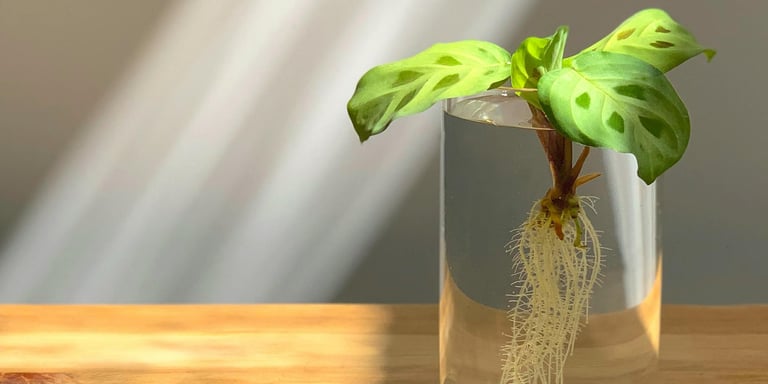

How Auxins Impact Plant Growth
When you apply rooting hormones to a plant cutting, they help create new roots by mimicking natural plant hormones. It's like giving the plant a little nudge to grow roots. Rooting hormones work by mimicking the natural auxins produced by plants. When applied to a cutting, the synthetic auxins promote the formation of root cells at the base of the cutting. This process involves several key steps:
Auxin Absorption: When you apply auxin to a cutting, it is absorbed through the plant's surface, often through specialized structures like stomata or directly through the epidermal cells. This absorption process is critical as it allows the auxin to penetrate the plant tissue and reach the cells where it will initiate root development.
Cellular Changes: Once inside the plant tissue, auxins trigger significant cellular changes. They activate specific genes that stimulate cell division in the root meristems, which are the regions of active cell division at the tips of roots. This activation leads to the formation of new root cells, contributing to the growth and elongation of the root system. Auxins also enhance cell elongation by loosening the cell walls, allowing cells to expand and grow.
Root Primordia Formation: Auxins play a pivotal role in the formation of root primordia, which are small groups of cells that will develop into roots. In cuttings, auxins stimulate the formation of adventitious roots, which arise from non-root tissues such as stems or leaves. This process involves the reprogramming of existing cells to form new root meristems, setting the stage for new root growth.
Root Elongation: After the root primordia are formed, auxins promote the elongation of these newly formed root cells. This elongation process helps the roots grow longer and stronger, enhancing their ability to penetrate the soil and anchor the plant. The elongating roots also improve the cutting's ability to absorb water and nutrients, essential for the overall health and growth of the new plant.
The Role of Auxins in Root Development
Auxins are special hormones that help plants grow roots. They ensure roots grow properly and spread out to find water and nutrients. Auxins are vital plant hormones that regulate various aspects of plant growth and development. In root development, auxins play a key role by:
Initiating Root Formation: Auxins play a pivotal role in root formation by stimulating the development of root primordia, which are groups of cells that will eventually form new roots. In seedling roots, auxins promote the growth of these primordia at the root tip, ensuring the primary root elongates and branches effectively. For adventitious roots formed from cuttings, auxins trigger the formation of root primordia at the cut sites. This process involves the differentiation of previously non-root cells into root cells, setting the stage for new root growth. By initiating root primordia formation, auxins enable plants to establish a robust root system, essential for water and nutrient uptake and overall plant stability.
Promoting Cell Elongation: Auxins play a crucial role in the elongation of root cells by increasing the plasticity of the cell walls. This process enables cells to stretch and grow, resulting in longer and more robust roots. The elongation of root cells allows the roots to penetrate deeper into the soil, improving the plant's stability and access to water and essential nutrients. By facilitating deeper root growth, auxins help plants anchor themselves more securely in the soil and increase their ability to withstand environmental stresses, such as drought or nutrient deficiency.
Regulating Root Architecture: Regulating Root Architecture: Auxins play a crucial role in shaping the overall structure of the root system. They promote the formation of lateral roots, which branch out from the primary root, thereby increasing the root network's reach and stability. This branching enhances the plant's ability to explore the soil for nutrients and water. Additionally, auxins stimulate the development of root hairs on the surface of the roots. These tiny hair-like structures significantly increase the surface area of the root system, allowing for more efficient absorption of water and essential nutrients from the soil. By influencing both lateral root formation and root hair development, auxins ensure that the root system is well-architected for optimal growth and resource uptake.
Balancing Hormonal Interactions: Auxins play a crucial role in balancing the effects of other plant hormones to ensure overall plant health and stability. For example, cytokinins promote cell division and shoot growth, while gibberellins stimulate stem elongation and seed germination. Auxins help regulate the distribution and concentration of these hormones within the plant, coordinating root and shoot growth. This hormonal balance ensures that the plant allocates resources efficiently, promotes optimal growth, and adapts to environmental conditions. By interacting with cytokinins and gibberellins, auxins maintain a harmonious growth pattern, contributing to the plant's ability to thrive.
Natural vs. Synthetic Auxins
Plants naturally produce auxins like Indole-3-acetic acid (IAA), which play a critical role in regulating plant growth and development. However, IAA's inherent instability makes it less practical for commercial use. When exposed to light and other environmental factors, IAA degrades rapidly, reducing its effectiveness as a rooting hormone. To address this limitation, synthetic auxins such as Indole-3-butyric acid (IBA) and Naphthaleneacetic acid (NAA) have been developed. These synthetic auxins are chemically engineered to be more stable, ensuring they remain effective over longer periods and under various conditions. This enhanced stability allows synthetic auxins to reliably stimulate root growth and improve the success rate of plant propagation. As a result, synthetic auxins are the preferred choice for commercial rooting products, providing consistent and reliable performance in promoting root development in plant cuttings. Their ability to maintain effectiveness makes them invaluable tools for gardeners, horticulturists, and agricultural professionals.
Different products contain different types of rooting hormones. Some are natural, whilst others are synthetic, and this can impact their role in propagation for plants. Let's explore the different functions of these hormones, and how they can impact plant growth:
Indole-3-Acetic Acid (IAA)
Indole-3-Acetic Acid (IAA) is a naturally occurring auxin found in plants that plays a crucial role in regulating various growth processes. As one of the most important plant hormones, IAA is essential for cell elongation, differentiation, and overall plant development. It is involved in processes such as:
Cell Elongation: IAA promotes cell wall loosening, allowing cells to expand and grow. This process is vital for the elongation of roots, stems, and leaves, contributing to the overall growth of the plant.
Differentiation: IAA influences the differentiation of cells, guiding them to develop into specific types of tissues and organs. This regulation ensures the proper formation of roots, shoots, and leaves.
Phototropism and Gravitropism: IAA helps plants respond to environmental cues by directing growth towards light (phototropism) or against gravity (gravitropism). This adaptive response enables plants to optimize their exposure to light and stabilize their anchorage in the soil.
However, IAA's natural instability and rapid degradation when exposed to light and other environmental factors make it less commonly used in commercial rooting products. Instead, synthetic auxins such as Indole-3-Butyric Acid (IBA) and Naphthaleneacetic Acid (NAA) are preferred due to their stability and longer-lasting effects.
For research or commercial purposes, IAA can be purchased online from suppliers like Sigma-Aldrich or Abcam. These products are typically used in laboratory settings to study plant growth and development or in specialized applications where natural auxins are required.
Indole-3-Butyric Acid (IBA)
Indole-3-Butyric Acid (IBA) is a synthetic auxin known for its stability and effectiveness in promoting root initiation. Unlike Indole-3-Acetic Acid (IAA), which degrades quickly when exposed to light and environmental factors, IBA remains stable and provides consistent results in stimulating root growth. This stability makes IBA a preferred choice in commercial rooting products, ensuring reliable and efficient root development in plant cuttings.
IBA works by mimicking the natural auxins found in plants, specifically targeting the formation of adventitious roots. When applied to cuttings, IBA enhances cell division and elongation at the cut site, leading to the rapid development of new roots. This process not only increases the success rate of plant propagation but also results in healthier and more vigorous plants.
Due to its effectiveness, IBA is widely used in various commercial rooting powders, gels, and solutions. These products are commonly available in garden centers and online retailers, making it accessible for both amateur and professional gardeners. IBA is often a key ingredient in many popular rooting products, providing the necessary hormonal boost to ensure successful propagation.
Naphthaleneacetic Acid (NAA)
Naphthaleneacetic Acid (NAA) is a powerful synthetic auxin widely used in various horticultural and agricultural applications. One of its primary roles is to promote root formation in plant cuttings, making it a popular choice for rooting products. By stimulating cell division and elongation at the cut site, NAA enhances the development of new roots, leading to healthier and more vigorous plants.
NAA is also commonly used in plant tissue culture to support the growth and differentiation of plant cells, tissues, and organs. Its effectiveness in promoting root growth extends to various plant species, making it a versatile tool in plant propagation.
Additionally, NAA plays a significant role in managing fruit crops. It is used to prevent fruit drop by promoting the retention of fruits on the tree until they reach maturity. This application is crucial for improving yield and quality in fruit production. Furthermore, NAA is employed to thin fruit clusters, ensuring that the remaining fruits have more space and resources to grow larger and healthier.
You can buy this commercially in Doff's synthetic rooting powder, where it is at a concentration of 0.43%. This product is designed to provide a consistent and reliable source of NAA for gardeners and horticulturists looking to enhance root development in their cuttings.
Summary Of Rooting Hormones
Rooting hormones can play a valuable part in houseplant propagation, giving us the chance for faster root development, and healthier overall growth long term. Over this article, we've explored the benefits of rooting hormones, along with the common myths and misconceptions, learning how they can benefit our houseplants. Let's explore the key points of this article:
Summary of Key Points:
Rooting hormones, such as IAA, IBA, and NAA, significantly enhance root development in plant cuttings. Using these hormones in appropriate concentrations, like in studies on Morus alba and gerbera plantlets, can lead to high rooting success rates.
Multiple applications of rooting hormones can further boost rooting efficiency, especially for slow-to-root plants. This technique can be applied both in soil and water propagation.
Natural rooting hormones, such as willow water, seaweed, or honey, offer organic alternatives that contain naturally occurring auxins and can be effective in plant propagation.
Real-world experiences from gardeners and online communities highlight the practical benefits and diverse methods of using rooting hormones, including natural alternatives and combining them with mycorrhizal fungi.
Final Thoughts on Rooting Hormones: Rooting hormones are powerful tools that can significantly improve the success rates of plant propagation. By understanding the different types of hormones and their optimal use, gardeners can achieve better rooting outcomes during propagation. While synthetic hormones like IAA, IBA, and NAA are highly effective, natural alternatives can also enhance root development and overall plant health. Combining these techniques with proper care and growing conditions ensures a higher likelihood of successful propagation, whether you're a professional grower or a home gardener. Embrace the science behind rooting hormones, experiment with different methods, and enjoy the rewards of healthy, thriving propagation.
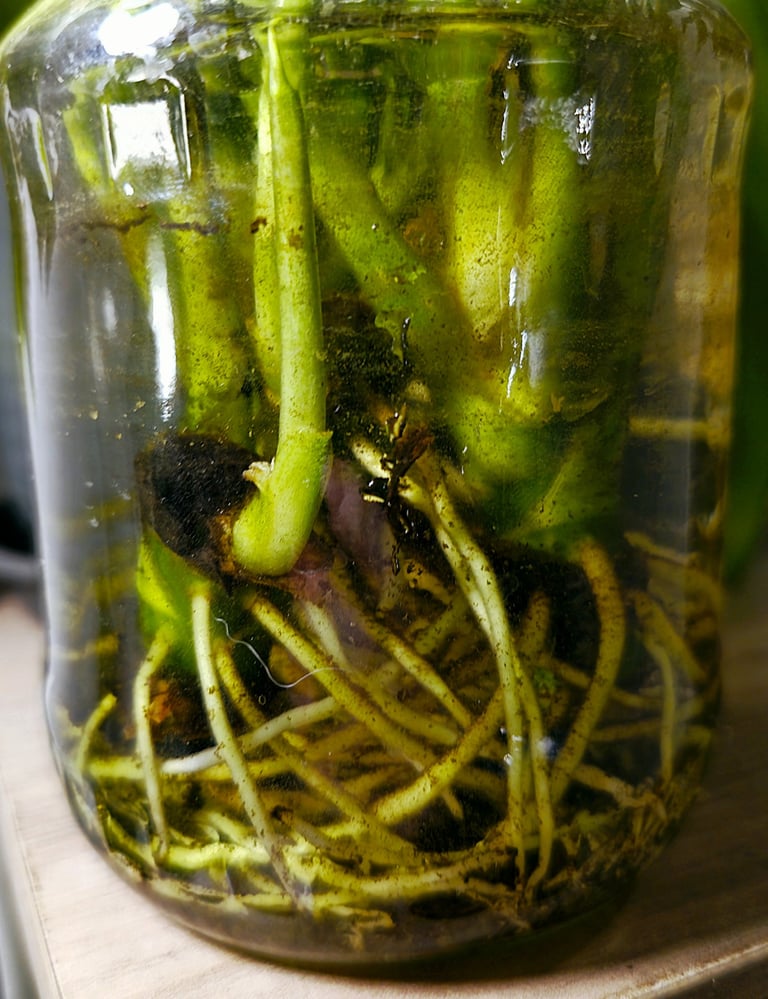

Additional Tips and Resources
Recommended Products:
Clonex Rooting Hormone: Available in liquid form, Clonex contains IBA and is known for its effectiveness in promoting root growth. Available at garden centers and online retailers.
Doff Rooting Powder: Contains IBA (Indole-3-butyric acid), commonly used for promoting root development in various plant cuttings. Suitable for soft, semi-hard, and hardwood cuttings.
Vitax Organic Rooting Powder: An organic option that stimulates root development without synthetic chemicals. Contains natural rooting hormones, including IBA.
Root !T Rooting Gel: Easy-to-apply gel that contains IBA for promoting root development.
Further Reading and Research:
Books:
Plant Propagation by Alan Toogood: Comprehensive physical reference guide on various propagation techniques.
The Reference Manual of Woody Plant Propagation by Michael Dirr and Charles Heuser: Detailed information on propagating woody trees, like Ficus.
Research Papers:
“Adventitious Root Formation in Cuttings: New Concepts, New Possibilities” by Bruce Geneve: Explore the latest research in root formation. The study reviews recent progress in understanding adventitious root formation, highlighting that rooting is a multiphase process with distinct requirements at each stage. It discusses the roles of wounding-related compounds, auxins, ethylene, and phenolic compounds during these phases. The authors also emphasize the importance of molecular studies in uncovering the mechanisms underlying adventitious root formation and suggest that these findings could lead to advanced rooting treatments.
“The Role of Auxins in Plant Growth and Development” by Thomas Woodward: In-depth look at how auxins influence plant growth. The study provides an in-depth review of the phytohormone auxin, focusing on its regulation, action, and interaction with other plant hormones. It discusses the mechanisms plants use to control auxin levels, the movement of auxin through the plant, and the emerging view of auxin-signalling mechanisms. The authors highlight the importance of auxin in orchestrating many developmental processes and its role in plant growth and development.
Online Resources:
Propagation Guide: Houseplant Propagation
Pruning Guide: Pruning Houseplants
Edited & Fact Checked By: The Houseplant Shop
Article Published: 28th January 2025
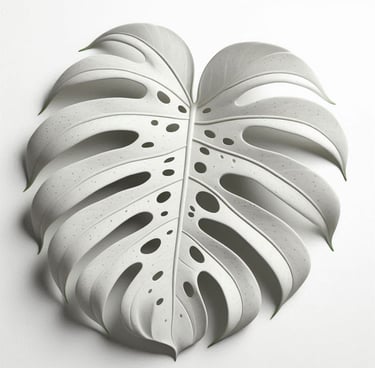

About The Houseplant Shop:
Independent Houseplant Nursery
Horticultural Specialists
Managing Over 250 Houseplant Species Onsite
Over 15 Years Of Experience With Horticulture
As head of horticulture, Sarah manages the care and propagation of over 250 plant species at a commercial houseplant nursery. With over 15 years of experience in horticulture, specializing in houseplants, Sarah has extensive expertise in plant biology, soil science, and integrated pest management. She continually reviews and integrates the latest research into her plant care guides. Dedicated to educating others, Sarah has spent years diagnosing houseplant care issues and sharing her real-world experience. Her commitment to scientific accuracy and helping people diagnose plant health issues has established her as a trusted authority and expert in the field.
The Houseplant Shop is a dedicated houseplant nursery, growing all of their own stock from their botanical library of over 250 houseplant species. The nursery staff are horticultural experts who have dedicated their lives to cultivating and nurturing over 250 different species of houseplants, focusing on Aroids, tropical plants, and NOID collectables. All their plants are grown in house in Britain to be more environmentally friendly. The nursery is proud to have been featured by the Royal Horticultural Society (RHS) as a 100% peat free nursery.
Recommended Further Reading:
People also looked at: Propagation, Pruning. Fertilizer, Artificial Lighting, Temperature, Watering, and Houseplant Care Guides By Species.
How We Reviewed This Article:
Our horticultural experts continually monitor the houseplant space, and we update our articles when new information becomes available. We are committed to providing current and reliable information. If you have some information that you think would be helpful in this article, we'd love to hear from you. Our team works hard to revise articles for factual accuracy, and we regularly update our pages with new information, techniques, tips, images, trade secrets, and real world experience from the team here at the houseplant nursery. You can find a list of the article updates below.
Written By: Sarah Brooks, Head of Horticulture
Article Received: 22nd January 2025
Copyright: The Houseplant Shop (https://thehouseplant.shop)
The use, distribution, or reproduction is permitted, provided the original copyright owner is credited and that the original publication on this website is cited with a direct link to the article, only with these terms. Any other use is not permitted.
List of Article Updates:
7th February 2025: UI update
Author Bio:
Author: Sarah Brooks
Head of Horticulture at The Houseplant Shop

